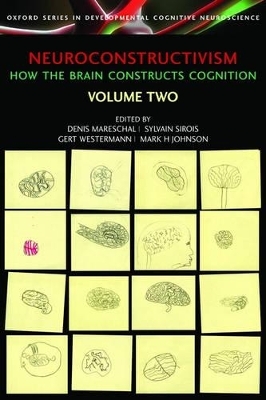
Neuroconstructivism - II
Oxford University Press (Verlag)
978-0-19-852993-4 (ISBN)
What are the processes, from conception to adulthood, that enable a single cell to grow into a sentient adult? The processes that occur along the way are so complex that any attempt to understand development necessitates a multi-disciplinary approach, integrating data from cognitive studies, computational work, and neuroimaging - an approach till now seldom taken in the study of child development.
Neuroconstructivism is a major new 2 volume publication that seeks to redress this balance, presenting an integrative new framework for considering development. Computer and robotic models provide concrete tools for investigating the processes and mechanisms involved in learning and development. Volume 2 illustrates the principles of Neuroconstructivist development, with contributions from 9 different labs across the world. Each of the contributions illustrates how models play a central role in understanding development. The models presented include standard connectionist neural network models as well as multi-agent models. Also included are robotic models emphasizing the need to take embodiment and brain-system interactions seriously. A model of Autism and one of Specific Language Impairment also illustrate how atypical development can be understood in terms of the typical processes of development but operating under restricted conditions. This volume complements Volume 1 by providing concrete examples of how the Neuroconstructivist principles can be grounded within a diverse range of domains, thereby shaping the research agenda in those domains.
1. Introduction ; 2. Constructing visual function through prenatal and postnatal learning ; 3. Learning the best first: interactions between visual development and learning ; 4. Why let networks grow? ; 5. Modeling cognitive developmental transitions in neural networks: bifurcations in an adaptive resonance theory model ; 6. Connectionism in an artificial life perspective: simulating motor, cognitive and language development ; 7. Using robots to study the mechanisms of imitation ; 8. What neuro-robotic models can teach us about neural and cognitive development ; 9. Phonological deficits and developmental language impairments: evidence from connectionist models ; 10. A neural network model of autism: implications for theory and treatment ; 11. Conclusion - the future of neuroconstructivism
| Erscheint lt. Verlag | 18.1.2007 |
|---|---|
| Reihe/Serie | Developmental Cognitive Neuroscience |
| Zusatzinfo | 52 line illustrations and 14 black & white photographs |
| Verlagsort | Oxford |
| Sprache | englisch |
| Maße | 156 x 232 mm |
| Gewicht | 433 g |
| Themenwelt | Geisteswissenschaften ► Philosophie |
| Geisteswissenschaften ► Psychologie ► Entwicklungspsychologie | |
| Geisteswissenschaften ► Psychologie ► Test in der Psychologie | |
| Naturwissenschaften ► Biologie ► Humanbiologie | |
| Naturwissenschaften ► Biologie ► Zoologie | |
| ISBN-10 | 0-19-852993-7 / 0198529937 |
| ISBN-13 | 978-0-19-852993-4 / 9780198529934 |
| Zustand | Neuware |
| Haben Sie eine Frage zum Produkt? |
aus dem Bereich


